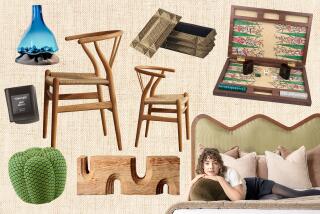At Last, a Miniature House of Her Own
At our house, 1999 will be remembered as the year my wife, Sara, got her dollhouse, fulfilling a dream she has cherished since she was 7.
Sara collected dollhouse furnishings and miniatures for 30 years. Her collection of tiny objects filled five display boxes that hang on our den wall. But she never had a dollhouse in which to put her miniatures.
Finally, when she turned 70 last year, I told her I would buy her a dollhouse as a birthday present. Iâve come to believe that retirement is a time to make your dreams come true.
As a collector of miniatures, Sara has lots of company. Some build and furnish their own dollhouses. Others create and build miniatures, often in exquisite detail. Hundreds of dealers sell dollhouses and related items in stores and at shows.
The U.S. dollhouse and miniature industry is of significant size. Manufacturers shipped about $60-million worth of dollhouses, miniatures and related items in 1997, the last year for which government data is available. Four trade associations represent various segments of the hobby. Three national magazines cover the industry.
*
Travel companies run special tours to dollhouse shows, dollhouse museums and private collections. And displays of miniatures can be seen at more than 60 museums nationwide.
Within the industry, however, opinions vary on its current health. âThe industry is flat,â said John K. Purcell, executive director of the National Assn. of Miniature Enthusiasts. The group, which now has 8,000 members, had 11,000 members in the mid-1970s.
Jim Myers, president of dollhouse manufacturer Dura-Craft Inc. of Newberg, Ore., said sales are slumping because some mega-craft stores have stopped selling dollhouses. Myers also noted the competition from computers and video games: âTheyâre sexier and more fun than sitting down with Dad and building a dollhouse.â
Dollhouses can cost $40 to $1,000. Prices of miniatures vary widely too, depending on quality.
While most dollhouses are intended for children, there are elaborate dollhouses for adults who collect high-quality miniature furnishings. Indeed, the worldâs greatest dollhouses--such as Queen Maryâs Dollsâ House at Windsor Castle in England and the celebrated Thorne Room boxes in the Art Institute of Chicago--were created by adults for adults.
I asked Steve Klein, 57, of Encino why miniatures fascinate so many adults. Klein, a former family therapist who sells real wine in tiny bottles to dollhouse collectors, said: âItâs a matter of creating a little fantasy world that you can control. Fantasy and control are in short supply in the real world.â
Soon after Sara and I began searching for her âdreamâ dollhouse, we found Foxhall Manor--an eclectic three-story mansion with space for a roof garden on one end and a conservatory on the other--that had come on the market in 1993. Like most dollhouses, it came as a kit; assembled, it measured 5 1/2 feet long, 2 feet deep and 3 feet high.
Many people put dollhouses together themselves. Sara and I took the house to Gary and June LaPorta at Miniatures From the Attic, a dollhouse shop in the Washington, D.C., suburb of Falls Church, Va.
It took time to build Saraâs âdreamâ house. Assembling the wooden structure was only the first step. Putting on the siding, painting the outside and covering the roof with asphalt shingles came next. Gary LaPorta then installed electrical tape so Sara could have light in her house.
*
Rooms were wallpapered and moldings were installed. Some floors were tiled, others carpeted. LaPorta built bookcase units for the library and installed a fireplace. Finally, he hung chandeliers and light fixtures.
The house, you might say, has all the comforts of home.
âItâs just like building a real house,â LaPorta observed. Indeed, Sara and I drove over every few weeks to check on the progress, and decide on wallpaper, carpeting and fixtures.
With each new addition, Sara would squeal: âI love it! I just love it!â Her excitement was contagious and gratifying. Said June LaPorta, âSara kept it fun for us.â
In the meantime, Sara was arranging for furnishings.
The kitchen cabinets and appliances were by woodworker Ron Vogler, 62, of Rochester, N.Y. In 1979, when his daughter Kathleen was 16, Vogler said, he built a dollhouse and furnishings for her. He and his wife, Mary, became active in miniatures groups and began attending shows nationwide under the name M&R; Miniatures. Now he makes about 40 different upper and lower basswood kitchen cabinets and miniature appliances, including refrigerators, stoves and dishwashers.
Sue Sharp of suburban Vienna, Va., proprietor of Sharp Mini Designs, did the window treatments: lace curtains on brass rods for the conservatory, pinch-pleated cornices and drapes for the library, and tie-back curtains for the bedroom, bath and kitchen. Sharpâs curtains and drapes not only look real, they are real--theyâre just much smaller than the life-size version.
*
Sharp says she gets many design ideas from books and magazines, âthen I have to figure out how to shrink it,â she says.
One of Saraâs favorite pieces is a miniature cello, made by Orvin Fjare, 81, of Big Timber, Mont. Fjare (pronounced fee-AIR-ee) built his first miniatures in 1985, starting with musical instruments and then moving into an array of desks and clocks.
His signature pieces are Wooton desks, miniature copies of the popular desks produced in the late 1800s by Indiana cabinetmaker William Wooton. The elaborate desk, called a cabinet secretary, has brass handles and hinges and nearly 100 drawers, compartments and cubbyholes. And everything works. Fjare said it takes him 150 hours to make a Wooton desk; the current wait for a desk is about a year.
After Foxhall Manor was transformed from a pile of flat boards into an elegant house--which took about six months--we brought it home. Sara was in a daze.
âIt leaves me breathless and speechless when I look at it and realize itâs mine,â she said. âThat little 7-year-old girl is still there inside of me, and she finally got her dollhouse.â
More to Read
Sign up for The Wild
Weâll help you find the best places to hike, bike and run, as well as the perfect silent spots for meditation and yoga.
You may occasionally receive promotional content from the Los Angeles Times.






